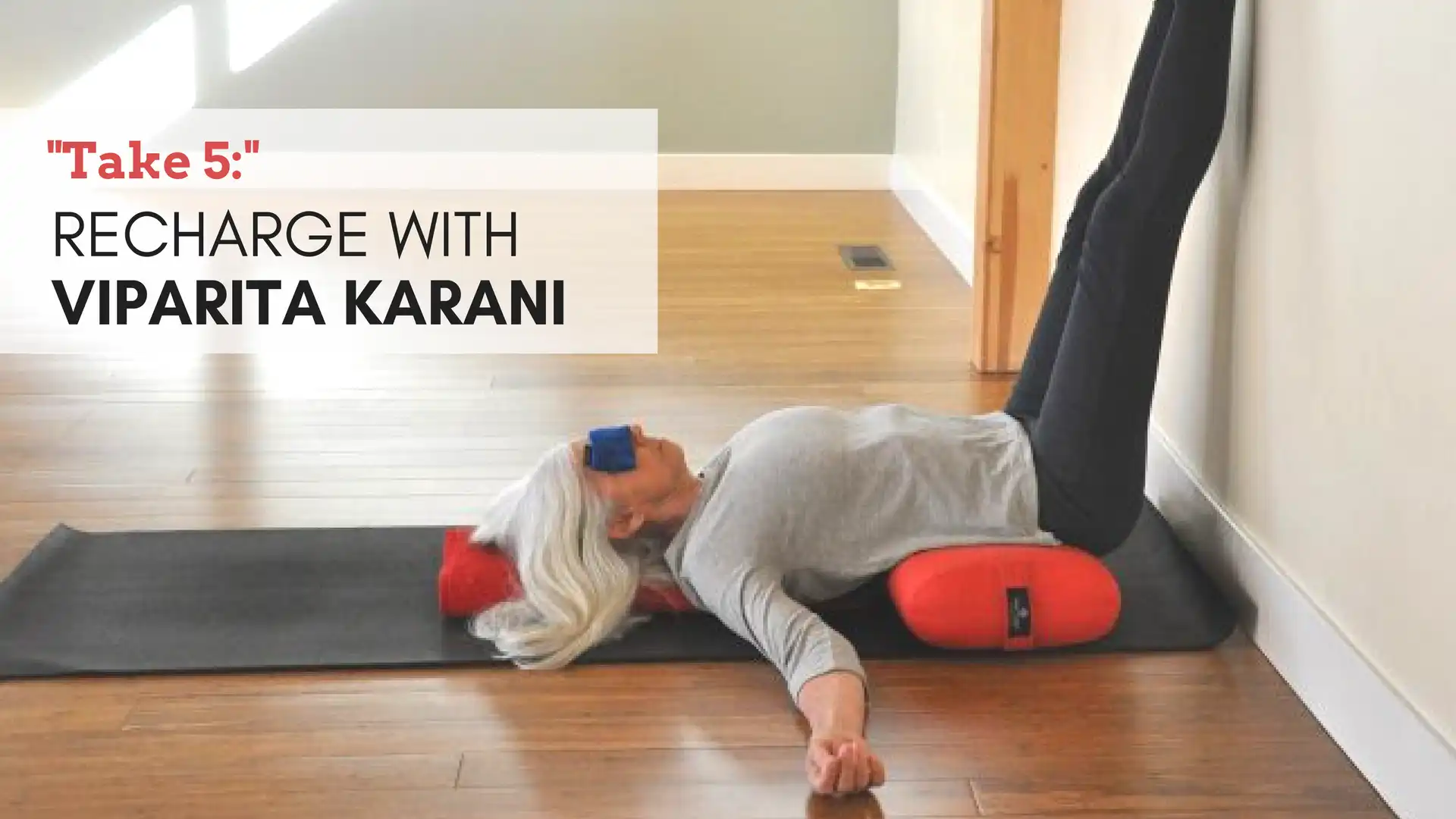Take 5- Recharge with Viparita Karani (Legs Up the Wall Pose)

Often we think of “power yoga” as a high-energy, heat-infused workout that leaves us exhausted—in a good way. In terms of asana practice, there’s more than one way to understand what is powerful. The power of the eight-limbed path of yoga comes from the quieting of the body/mind. Sanskrit scholar and sutra translator Alistair Shearer translates Patanjali’s sutra 1.2 as, “Yoga is the settling of the mind into silence.”
Because of its power to calm the body, and therefore the mind, I consider restorative yoga to be a form of “power yoga.” One of restorative yoga’s most powerful poses evokes, Viparita Karani (Clear Lake Pose or Legs Up the Wall Pose) a cool, crystalline mountain lake. I call Viparita Karani the great neutralizer, as it has the potential to rejuvenate tired, stressed-out bodies as well as calm runaway minds.
Viparita Karani is a curious mix: It’s an inversion, a backbend, and a restorative pose. Inverted poses nourish the endocrine glands, promote circulation, balance metabolic function and increase blood flow to the brain. The inverted orientation, combined with neck flexion (chin moving toward chest) stimulates the baroreflex, a chain of chemical reactions that suppress the sympathetic (fight-or-flight) nervous system and let us rest in the parasympathetic (rest-and-digest) side.
Backbends are exhilarating and can brighten the heaviness of fatigue. Backbending expands the rib cage, freeing the lungs for deeper breathing, and opening the heart area. The combination of backbending and inverting rejuvenates our energy by promoting free respiration and bringing about profound rest. The effect is a deep, internal cooling of the physical, mental and emotional bodies.
How to Practice Viparita Karani (Legs Up the Wall Pose)
To get started, you’ll need up to three firm blankets (wool or cotton are best) or a yoga bolster and one firm blanket. It’s possible to practice with just one firm blanket if that’s what you have on hand. You may also want to use a strap and an eye bag.
- Fold two of your blankets into a bolster size (eight to ten inches wide), and stack one on top of the other. Alternately, use a standard-sized (flat) yoga bolster.
- Place your stack of blankets or your bolster parallel to, and four to eight inches from, the wall.
- Fold your other blanket to the same size and place it perpendicular to the other two blankets or bolster, forming a “T” shape.
- Sit on the right end of your stacked blankets so that your left side is touching the wall.
- Tuck your knees in toward your torso and carefully roll to the left toward the center of your stack so that you end up on your back with your legs extending up the wall and the tops of your shoulders and back of your head resting on the third blanket. Your buttocks will hang slightly off the blanket. Adjust your position so that the perpendicular blanket is centered under your shoulders and head.
- Viparita Karani’s “clear lake” refers to the oval area from the bottom of your breastbone to the top of your pubic bone. In order for your lake to be clear, it must be horizontal. If the lake is tilted toward your head, its waters will spill out toward your chest and head, creating agitation. So make sure that your entire abdomen is horizontal. Move your blankets away from the wall if necessary.
- You might enjoy placing a strap around your thighs to prevent your legs from splaying apart. Use an eye bag if you have one.
- If your legs tire of being upright, or if they start to tingle, bend your knees and lower them into a cross-legged position while the rest of your body stays in Viparita Karani.
- Let go of resistance to gravity. Breathe naturally and let your consciousness expand throughout the entire body. Let thoughts come and go. Relax and let go of control.
- Comfort is paramount. Pain or discomfort can agitate the body/mind and will diminish the effects of the pose. If your back is uncomfortable, try lying flat on the floor with no blankets to elevate your hips, and extend your legs up the wall.
- You can stay in the pose as little or as long as you like—5 to 20 minutes or more. I like to breathe deeply for the first minute or so and then let my body breathe itself, with no effort.
- When you are ready to leave the pose, bend your knees and slide your feet down the wall.
- Roll onto either side and pause there before gently pushing up to a sitting position.
- It’s important to leave Viparita Karani with care and mindfulness, to preserve the calm energy you’ve generated by practicing the pose.
Legs Up the Wall: Contraindications
Viparita Karani is contraindicated in some cases. People with eye conditions such as glaucoma and detached retina should not invert. Nor should those with hiatal hernias or heart conditions. Women should not practice inversions during menses. Backbends are contraindicated for people with spinal issues such as spondylolisthesis or spondylolysis, and for pregnant women in their second and third trimesters.
People with controlled high blood pressure can modify by lying flat on the floor with their legs up the wall, increasing the height under their hips gradually over months of practice. It’s a good idea to check the effect of the pose with a blood pressure monitor after you’re finished.
Viparita Karani reenergizes your legs after a vigorous hike or run, or after a long period of standing. It’s the best pose I know to settle an agitated, insomniac mind. It simultaneously calms and rejuvenates. Viparita Karani is a cool, luxurious oasis you can visit anytime.
 Charlotte Bell began practicing yoga in 1982 and began teaching in 1986. She was certified by B.K.S. Iyengar in 1989 following a trip to Pune. In 1986, she began practicing Insight Meditation with her mentors Pujari and Abhilasha Keays. Her asana classes blend mindfulness with physical movement. Charlotte writes a column for Catalyst Magazine and serves as editor for Yoga U Online. She is the author of two books: Mindful Yoga, Mindful Life and Yoga for Meditators, both published by Rodmell Press. She also edits Hugger Mugger Yoga Products¹ blog and is a founding board member for GreenTREE Yoga, a non-profit that brings yoga to underserved populations. A lifelong musician, she plays oboe and English horn in the Salt Lake Symphony and the folk sextet Red Rock Rondo whose 2010 PBS music special won two Emmys.
Charlotte Bell began practicing yoga in 1982 and began teaching in 1986. She was certified by B.K.S. Iyengar in 1989 following a trip to Pune. In 1986, she began practicing Insight Meditation with her mentors Pujari and Abhilasha Keays. Her asana classes blend mindfulness with physical movement. Charlotte writes a column for Catalyst Magazine and serves as editor for Yoga U Online. She is the author of two books: Mindful Yoga, Mindful Life and Yoga for Meditators, both published by Rodmell Press. She also edits Hugger Mugger Yoga Products¹ blog and is a founding board member for GreenTREE Yoga, a non-profit that brings yoga to underserved populations. A lifelong musician, she plays oboe and English horn in the Salt Lake Symphony and the folk sextet Red Rock Rondo whose 2010 PBS music special won two Emmys.



